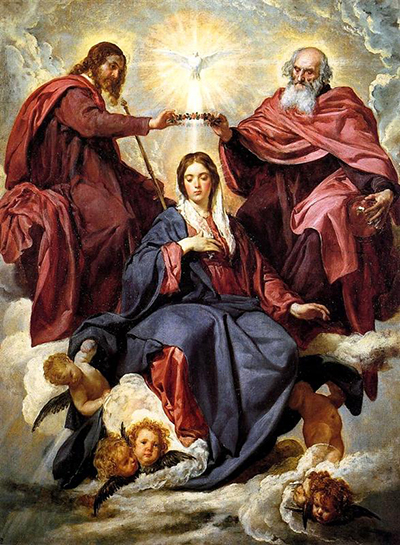Coronation of the Virgin
Coronation of the Virgin is an unusual painting for Velazquez. Usually known for his large portraits, this painting is much smaller than his other works and is one of only a few depicting a religious scene.

This painting is an oil on canvas work depicting the coronation of the Virgin Mary in Heaven by the Holy Trinity – the Father, Son and Holy Spirit. This is a common theme seen in European Baroque work of the time and is an excellent and very attracting example of Marian art.
There is some discrepancy over when the painting was finished, with most sources estimating that it was created in the early 1640s, although some research suggests that it may have been as early as 1636.
It was commissioned for the oratory of Queen Elizabeth of Bourbon, the queen consort to Philip IV of Spain. It was intended to complete a series of nice paintings entitled ‘The Fests of Our Lady’ which already hung in the chapel which may account for the smaller than usual canvas size as Velazquez tried to make his work fit with the others in the series.
This clear contrast in subject matter and style is intriguing because it shows Velazquez’s clear skill and adaptability.
The most immediately obvious thing when looking at this painting is the triangular composition and symmetry of the three central figures which again contrasts with the artist’s usual style. The Holy Spirit exists in the form of a dove at the top of the painting and this completes the triangle, drawing it down into a heart shape, a symbol for reverence and piety in this context. This is mirrored by Mary’s own pose with her hand pointing towards her heart.
Mary is clearly the main character here, placed in the centre of the composition and with an expression of grace and piety which reflects the way she was regarded in Europe. Velazquez has painted her with a deliberately youthful face, typical of Baroque depictions and attitudes towards of the virgin mother. Her eyes are lowered and she is a true depiction of modesty and virginity, attributes which were held in extremely high regard.
Jesus and God wear the same bright purple robes evoking a sense of unity and harmony, the bright colours being typical of baroque painting, however the choice of purple over the more common red is an interesting stylistic choice setting Velazquez above his contemporaries. The colour choices here are highly attractive and give a sense of heaven as a beautiful, joyful place.
Like much of Velazquez’s work, this painting displays a high level of realism, further bringing the scene to life. The detail of the faces as well as the cherubs which play around the base of the scene add further to the reverence of the scene and serve to create an image which is both highly attractive and highly pious.